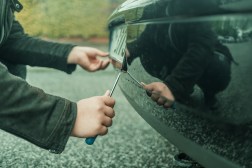New vehicle and people tracking software doesn’t need biometrics or license plates

The artificial intelligence firm Veritone on Thursday unveiled a new version of its Track product, an object-recognition service designed to track people and vehicles across numerous video feeds and large volumes of footage.
Jon Gacek, general manager of the company’s public sector business, told StateScoop the original version of the product was born from a need by law enforcement to track suspects during events like riots and high-profile property crimes, like retail theft. But, he said, the recent addition of vehicle tracking, which does not depend on scanning license plates, has been highly anticipated by police.
“Our technology is open, it’s for people and vehicles, it can run at scale, because it’s cloud-based and because we do millions and millions of hours of content every quarter,” Gacek said.
Automated license plate readers, a separate technology, have become widespread over the past decade, helping police automatically check for matches against federal watch lists. According to the American Civil Liberties Union, cameras from one popular vendor, Flock Safety, are installed on roadways in at least 2,000 cities.
Gacek said law enforcement agencies are interested in tracking vehicles without relying on license plates, however, because criminals often remove or change their plates.
Veritone’s website advertises that Track can be used to find criminal suspects in public or private settings, “without using biometric data,” or to find missing people, such as human trafficking victims. Gacek explained that the software does not use facial recognition, but relies on other attributes, like height or distinguishing clothing or marks, to track people or objects, like vehicles.
Property crime, like the organized retail thefts that have captured headlines in many large cities around the country in recent years, has among the lowest solve rate of any crime category. Many estimates, including one from the Public Policy Institute of California, place the solve rate for property crimes at less than 10%.
Gacek said law enforcement could use technology’s help. He recalled a conversation with a police chief at a major university who has access to 3,000 cameras, but no practical way of monitoring all the feeds.
“With all the cameras and the like, these agencies spend a lot of money putting in this investment, but what human is going to watch it all?” he said.
Gacek said the technology is currently “in trials” with “a bunch” of customers, including law enforcement agencies and law firms representing police that want to find suspects involved in riots.
“They need to track some very specific people on a lot of content,” he said. “They know who the people are. The use case is they generally know who they are and you’re just trying to find them.”
When it comes to object-recognition technology, which relies on machine learning algorithms and large volumes of training data, there’s nothing special about vehicles. Gacek said the software could eventually be used to track other objects as customers request them. Tracking military vehicles, he said, is one such possibility for a new feature.






